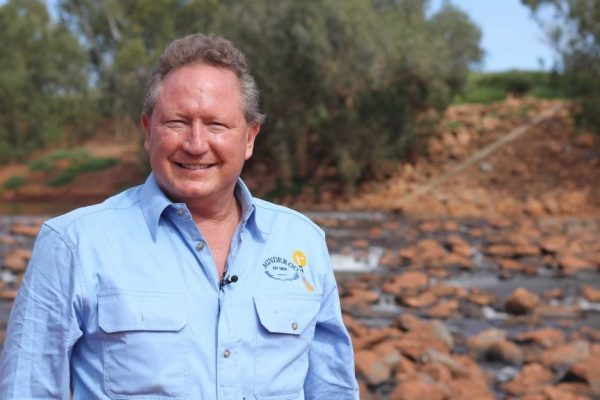(ATF) One of Australia’s richest men, iron ore magnate Andrew Forrest, is urging government leaders to develop “green” steel-making facilities. The billionaire from Perth says he aims to begin work on a pilot plant later this year to capitalize on the country’s vast iron ore reserves and powered by a new form of energy that is emissions-free and has the potential to replace coal: green hydrogen.
Forrest is the founder of Fortescue Metals Group, which is generating considerable sums currently – with output reportedly worth US$940 million in December alone – by selling iron ore to China at prices that now top US$170 a tonne.
Forrest and his wife are philanthropists who have pledged to give away the bulk of their wealth to charity and support a range of worthy causes, such as education, indigenous Australians, the fight against slavery, and now, the fight against climate change.
The mining boss’ latest endeavour has vast money-making potential but his focus is more on cleaning up the ‘dirty business’ he has made his fortune from – by eliminating emissions caused by the production of steel and combating global warming.
“The green hydrogen market could generate revenues – at the very least – of $US12 trillion (A$15 trillion) by 2050, bigger than any industry we have,” he said in a lecture that was shown on national television on Saturday.
“And Australia, with characteristic luck, is sitting on everything it needs to be the world leader – but only if it acts fast.”
The steel-making industry involves heating iron ore with coking coal in blast furnaces at very high temperatures. This sector is a significant contributor to global warming, reportedly responsible for 8% of global emissions.
Forrest wants to eliminate those emissions. He says companies producing steel can use hydrogen in a much better process, because it burns cleanly and emits only water.
“Green hydrogen” is the term for the process in which hydrogen is generated via renewable energy, as it is emissions-free.
“You replace coal in the furnace with our old friend, green hydrogen. You get steel – but instead of emitting vast clouds of CO2, you produce nothing more than water vapour,” Dr Forrest said.
But the technology is generally not used in steel making because of the costs involved, and experts say it could take years before the process is economically feasible.
‘Scrap the blast furnace’
However, Forrest wants his company, Fortescue, to try more “radical” methods – “scrap the blast furnace and just zap the iron ore with renewable electricity”.
“We produce over 40% of the world’s iron ore. And our potential green energy and hydrogen resources are immeasurable,” he said.
“If Australia were to capture just 10% of the world’s steel market, we could generate well over 40,000 jobs – more than what’s required to replace every job in the coal industry. Not any old jobs, but similar jobs – construction workers, mechanics, electricians, engineers – all of the sectors that’ll be hit when coal is phased out.”
Energy experts are unsure if hydrogen can replace coal in the steel-making process but they have said it is feasible, particularly for someone like Forrest, given his deep pockets.
Hydrogen is abundant, cheap and clean burning, but it is reportedly difficult to transport – it may need to be converted to ammonia, then converted back into hydrogen at the destination where it will be used. It can make metal brittle and is also a lot more explosive than petrol. However, solutions to these issues are the subject of intense research currently.
Many shades of hydrogen
There are, in fact, many different shades of hydrogen, but Forrest appears to have timed his venture well, with the new US President Joe Biden keen to boost clean energy and the European Union scaling up renewable hydrogen projects. Meanwhile, the biggest countries in Asia are all anxious to reduce pollution and develop renewable sources of power.
Tim Buckley, an energy market analyst from the Institute for Energy Economics and Financial Analysis (IEFA), told the ABC it was estimated that the price of green hydrogen will drop 70% over the coming decade in countries with access to cheap renewable power.
“Where green hydrogen is almost inevitably going to work is where green energy is going to be almost free,” he said. “Places like Rajasthan in India or the Pilbara in Australia.”
And the Pilbara, of course, if where Forrest’s Christmas Creek iron ore mine is located, along with many other rust-coloured mountains, some of them up to 95% iron ore.
Currently, the Australian government is headed by a prime minister, Scott Morrison, who has long been an unabashed fan of coal. So, it is no surprise to hear that ‘ScoMo’ and his much-criticized advisers are cool on ‘green hydrogen’.
But it’s early days and it might take braver leaders to make this new source of energy happen.
Forrest has met Xi Jinping and is sometimes hailed as a friend of China. Maybe he will find backers more receptive to this sort of venture among the CCP in Beijing than Down Under. He plans to travel there soon.
ATF
.png)




